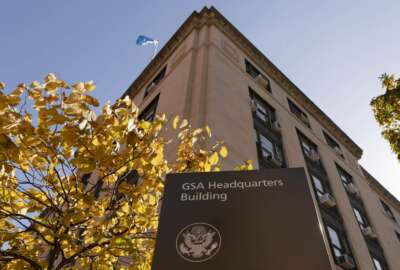

Tiffany Hixson, the assistant commissioner for the Office of Professional Services and Human Capital Categories in the General Services Administration’s Federal...
The General Services Administration is weeks away from releasing the solicitation for the next great multiple award contract, OASIS+.
The final request for proposals will be a culmination of thousands of comments and feedback from industry and government and two draft solicitations.
Tiffany Hixson, the assistant commissioner for the Office of Professional Services and Human Capital Categories in the GSA’s Federal Acquisition Service, said the final RFP will reflect the last two years of work to get OASIS+ in the best place possible.
“Given the amount of feedback that we got, it took us most of January and February to process that and so then we issued a second draft RFP on March 6. And the intent of that draft really was to say, ‘this is what we heard, here are the things that changed, here’s why we changed them based on feedback that we had received from an industry,’” Hixson said in an interview with Federal News Network. “We did host an industry day on March 15 to walk all of the offerors through what was in the second draft and what we’re trying to accomplish through some of the strategy changes. We had about 2,700 attendees at that event, which was really spectacular. We’re still getting feedback from industry on that second draft and we are crossing our T’s dotting our I’s, getting these last minute changes into the final RFP so we can get ready to release it.”
OASIS+ will replace the popular OASIS professional services contract. In fiscal 2022, agencies obligated about $12.9 billion through 530 task orders against the contract. Since 2015, agencies have obligated more than $55 billion through more than 3,600 task orders.

GSA had hoped to release the final RFP for OASIS+ by March 31. But Hixson said the timeline is now a few weeks away, given there were some specific features that required the agency’s senior procurement executive’s attention.
The changes from the first draft to the second draft to the final solicitation is driven by industry feedback and comments. GSA received more than 2,200 questions after the first draft. It also released a survey asking for industry input around specific elements of the acquisition strategy. The survey garnered 680 responses.
Hixson said the quantity of feedback helped drive both change and reinforced GSA’s strategy.
“We asked for feedback on the 10-year period of performance. How does it work for vendors? We got positive feedback. So we left that in. The North American Industry Classification System (NAICS) strategy, which are really important to ordering contracting officers and to the procurement itself, because NAICS codes really drive the domain that they’re going to compete task orders in, is another one we spent a lot of time working through. Do we have the right NAICS codes aligned to the functional areas or domains in the RFP? And we spent a lot of time with industry talking through that. The feedback that they gave us ranged from substantive would be like, ‘hey, we think you forgot these particular NAICS codes that really need to be in there’ to other minor details around making sure that NAICS codes lined up. It was really very, very helpful. So we made a number of changes related to the NAICS codes structures.”
Another big change coming to the final RFP is around contractor evaluations.

Hixson said GSA wanted to do contractor performance assessment system (CPARS) ratings at the top level of the contract, but industry offered ideas why that approach wouldn’t work.
It turns out the CPARS system doesn’t work well with long-term indefinite delivery, indefinite quantity (IDIQ) type of contracts because of the long lead time to market and win task orders generally associated with these vehicles.
“I think we’re going to work with industry and developing a performance scorecard that will be shared between our contracting officers and industry. So we can manage performance jointly throughout the ordering period of the contract,” Hixson said. “That was a really a meaningful round of dialogue with industry. Industry agrees that we need something to fall back on in terms of them being able to say ‘we performed really well.’ And overall, in the OASIS+ contract, they viewed as a good thing, we just need to think through the mechanics and put something in place that’s going to work for everybody.”
Hixson added the performance scorecard will take into account the 25 or so different performance requirements in OASIS+ and how companies are meeting or exceeding them. The requirements range from vendors having a cyber supply chain risk management plan to how they are competing for and winning task orders to how large firms are doing against their small business subcontracting plans.
Two other changes driven by industry feedback were around how contractors needed to submit greenhouse gas emissions data and how they can address supply chain risk management requirements.
Hixson said GSA is delaying the requirements to report greenhouse gas emissions until the final rule from the Federal Acquisition Regulations Council is out.
OASIS+ also will include supply chain risk management plans so industry feedback help GSA better understand how to ensure those requirements are achievable for companies and beneficial for agencies.
“That is something that is new to industry and we got some good feedback, especially on the small business side, about whether we can help them understand what we’re looking for, whether there are templates that they can use and whether we can support them with maybe some training, in terms of what the government’s expectations are,” Hixson said.
GSA also clarified potential challenges around teaming or joint ventures under OASIS+. This issue has hung up other contracts, including the CIO-SP4 GWAC from the National Institutes of Health’s IT Acquisition and Assessment Center (NITAAC).
“There’s some complexity around if a small business does decide to team, and no one has to have a team to be able to propose on OASIS+, but if they do choose to team and want to leverage the qualifications of one of their partners, there are some specific things that need to happen as part of the offer process. We got some good feedback around our language needing to be a little clearer around qualifying projects and experience levels,” Hixson said. “We’re not doing anything fancy on OASIS+ related to teaming or joint ventures. We literally are adhering to the standards of the Federal Acquisition Regulation (FAR) that allowed this and to the rules, in particular, for joint ventures with the Small Business Administration. There are no additional requirements that we’re baking into teaming, but there’s a lot of complexity there so we do spend quite a bit of time talking about that complexity and making sure that everybody understands, if you’re going to come in with a team and claim credit from you’re teaming partners, they have to be a small business, or a similarly situated small business and that kind of thing.”
Hixson said despite all of GSA’s best efforts to create an acquisition strategy and RFP based on industry feedback, she’s fully aware OASIS+ likely will have to deal with protests from unsuccessful bidders.
She said while her office has planned for protests as part of its timeline, GSA hopes some of the features built into OASIS+ will reduce the likelihood of protests.
“One, there is no cap on the number of awards we are going to make. Effectively, if you meet the standard of the contract program that you’re applying for, and there are six separate contract programs under OASIS+, and you are responsible you will get an award. We’re trying to make that very clear out of the gate,” Hixson said. “You should know before you submit your offer whether or not you’re going to meet that standard, or if you’re not, hopefully that will help.”
The second thing is around source selection process that includes on-ramps in the near future.
Hixson said it may take as much as two years for GSA to get through the first rounds of awards. Some in industry estimate that GSA could let 2,000 vendors on OASIS+ in the end.
“When we’re done with the initial source selection, we’re going to be reopening the solicitation and our goal is to leave that solicitation open for the duration of the program,” she said. “So when you’re ready to come in, you can if you miss the window to submit an offer, the window is going to open back up. If you’re new to the federal market, and weren’t interested three years ago because you’re a commercial company, but now you’re thinking maybe this government thing isn’t such a bad idea, you can come in and put in an offer. Hopefully that will help with some of the downward pressure that we get with companies feeling like they have been kind of locked out of the program.”
Copyright © 2025 Federal News Network. All rights reserved. This website is not intended for users located within the European Economic Area.
Jason Miller is executive editor of Federal News Network and directs news coverage on the people, policy and programs of the federal government.
Follow @jmillerWFED



